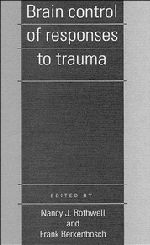Book contents
- Frontmatter
- Contents
- Contributors
- 1 Introduction
- 2 Responses to injury
- 3 Experimental approaches to the central nervous system control of responses to trauma
- 4 Neurohormonal control of cytokines during injury
- 5 Brain regions involved in modulation of immune responses
- 6 Psychological and neurobiological consequences of trauma
- 7 Central nervous system control of sickness behavior
- 8 Psychological and behavioural aspects of pain
- 9 Central control of cardiovascular responses to injury
- 10 Neuroendocrine responses to physical trauma
- 11 Central control of metabolic and thermoregulatory responses to injury
- 12 Central control of pain
- 13 The final word …
- Index
9 - Central control of cardiovascular responses to injury
Published online by Cambridge University Press: 05 August 2016
- Frontmatter
- Contents
- Contributors
- 1 Introduction
- 2 Responses to injury
- 3 Experimental approaches to the central nervous system control of responses to trauma
- 4 Neurohormonal control of cytokines during injury
- 5 Brain regions involved in modulation of immune responses
- 6 Psychological and neurobiological consequences of trauma
- 7 Central nervous system control of sickness behavior
- 8 Psychological and behavioural aspects of pain
- 9 Central control of cardiovascular responses to injury
- 10 Neuroendocrine responses to physical trauma
- 11 Central control of metabolic and thermoregulatory responses to injury
- 12 Central control of pain
- 13 The final word …
- Index
Summary
Introduction
The aim of this chapter is to review aspects of the central nervous organisation of the cardiovascular response to peripheral (non-central nervous) trauma. Two aspects of trauma are considered, namely haemorrhage or loss of circulating fluid and tissue damage or injury. In the context of this chapter, the term ‘injury’ is used to denote tissue damage and the associated activation of afferent nociceptive fibres, and does not itself involve loss of circulating fluid. The responses to haemorrhage and to injury are initially considered separately, before the interaction between the two responses, and the clinical implications of this interaction, are discussed. Finally, ways in which these responses may be modified by three groups of pharmacological agents are described: opioid agonists and antagonists, 5-hydroxytryptamine (5-HT) and ethanol.
Relatively little is known of the central nervous pathways specifically involved in the response to trauma. However, there is a wealth of knowledge regarding the pathways of individual cardiovascular reflexes that together may generate the response to trauma. It is therefore pertinent to describe first the cardiovascular responses to haemorrhage and injury, and their component reflexes, before discussing the relevant central nervous pathways.
The cardiovascular response to a progressive haemorrhage
The pattern of response to a ‘simple’ haemorrhage
A progressive ‘simple’ haemorrhage (loss of blood in the absence of major tissue damage, e.g. rupture of varices) produces a biphasic pattern of response (Figures 9.1, 9.2a). In the initial stages there is a progressive increase in heart rate and vascular resistance, which can maintain arterial blood pressure close to prehaemorrhage levels following blood losses of up to 10-15% of the blood volume in a young, otherwise healthy, individual (Barcroft et a\., 1944; Secher & Bie, 1985). However, as the severity of haemorrhage increases, and exceeds 20% of the blood volume, a very different pattern of response becomes apparent, namely a marked bradycardia and peripheral vasodilatation accompanied by a precipitous fall in blood pressure, which may lead to syncope (Barcroft et al, 1944; Figures 9.1, 9.2a).
Since the elucidation of the mechanisms (and central nervous pathways) of these responses to blood loss have involved investigations on animals, it should be stressed that the finer details of the response appear to vary depending on the species studied, and the choice of anaesthetic agent, if any (for example, see Schadt & Ludbrook, 1991).
- Type
- Chapter
- Information
- Brain Control of Responses to Trauma , pp. 202 - 238Publisher: Cambridge University PressPrint publication year: 1994
- 2
- Cited by



